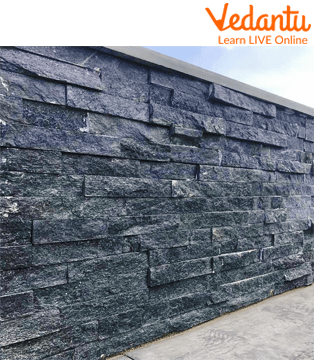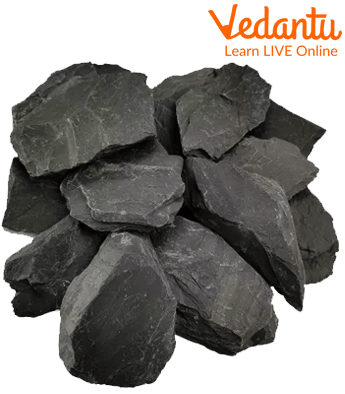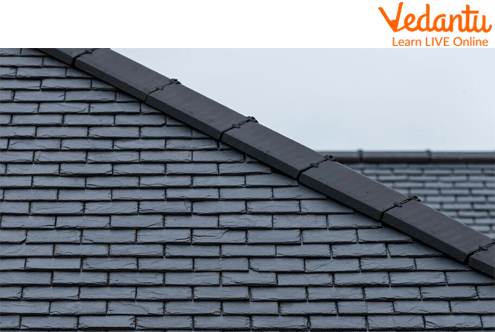




What is Slate?
Slate is a fine-grained, foliated metamorphic rock formed by the transformation of shale or mudstone by low-grade regional metamorphism. It is popular for various uses such as Roofing, Flagging, Flooring and Cladding, because of its stability and attractive appearance.

Slate Rock Cladding
Composition of Slate: Slate is composed primarily of clay minerals or maca, depending on the degree of metal change to which it has been subjected. Changing with increasing levels of heat and pressure in the original clay minerals in the shield. Slate may also contain abundant quartz and small amounts of feldspar, calcite, pyrite, hematite, and other minerals.

Slate Rock
How is Slate Used?
Most of the slate mined worldwide is used to produce roofing slate. Slate performs well in this application because it can be cut into thin sheets, absorb minimal moisture, and withstand cold water. The cost of slate and its installation is a disadvantage compared to other roofing materials. As a result, the new construction slate is mainly confined to high-end projects and prestige architecture.
Slate is also used for interior flooring and cladding, exterior paving, dimension stone, and decorative aggregate. Historical slate for chalkboards, student writing slate, billiard tables, cemetery markers, whetstones, and table tops has been used. Because it is a good electrical insulator, it was also used for early electrical panels and switch boxes.

Slate Rock Roofing
Why is Slate Used for Pool Tables?
Slate is solid rock with fine grains composed of several minerals, including quartz, clay and mica. It is ideal for pool tables because it naturally splits into wide, flat pieces, and can be easily ground and polished into a perfectly flat surface. While heavier and more expensive than wood, slate ensures that the playing surface remains smooth and level.
Table tops made of wood, as well as synthetics, can warp quite easily. Because it is so durable and is known to last, many manufacturers will offer a lifetime warranty for slate pool tables.
Solved Questions
Name the minerals content in slate rock.
Ans: Apatite, biotite, chlorite, feldspar, graphite, hematite, kaolinite, magnetite, pyrite, tourmaline and zircon are the minerals content in slate rock.
Write two uses of slate rock.
Ans: Roofing and flooring are the two uses of slate rock.
Write one disadvantage of slate.
Ans: Slate is costlier than other materials. This is the biggest disadvantage of slate.
Summary
In this chapter, we have seen many things related to Slate. Now we know what Slate is and its composition. We have also seen many uses of slate and also know why we can use Slate. Slate is also used for billiard tables, the same way as we have seen for pool tables. There are also some properties and advantages of slate and disadvantages that we discussed.
Learning by Doing
Write True or False.
Slate is a sedimentary rock.
Slate is formed from shale or mudstone.
Slate is used for Pool tables.
Slate is cheaper than other rocks.
FAQs on Uses of Slate Rock
1. What is the colour of Slate?
Most slates are grey in colour and range in a continuum of colours from light to dark brown. Slate also occurs in shades of green, red, black, purple and brown. The colour of the slate is often determined by the amount and type of iron and organic matter present in the rock.
2. When was the first Slate table made?
The first slate table was made in 1826.
How does Slate form?
Slate is a metamorphic rock, which means it is composed of other rocks. The slate begins as shale or mudstone, which then undergoes metamorphosis (exposure to heat and pressure), turning it into slate.









